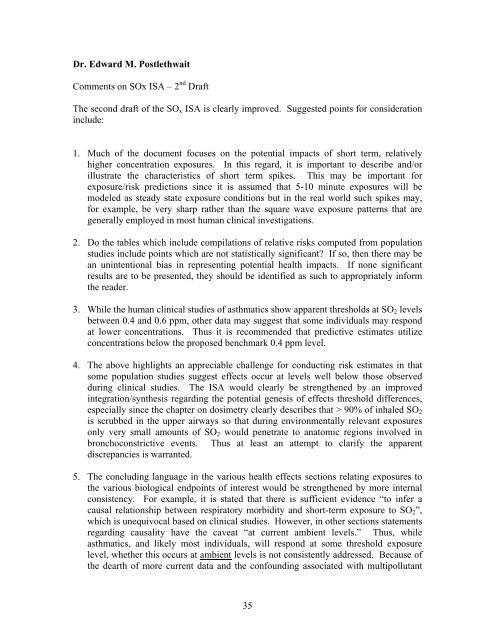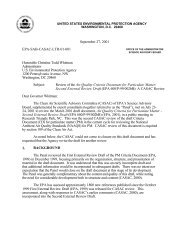(CASAC) Peer Review of EPA's Integrated Science Assessment
(CASAC) Peer Review of EPA's Integrated Science Assessment
(CASAC) Peer Review of EPA's Integrated Science Assessment
You also want an ePaper? Increase the reach of your titles
YUMPU automatically turns print PDFs into web optimized ePapers that Google loves.
Dr. Edward M. PostlethwaitComments on SOx ISA – 2 nd DraftThe second draft <strong>of</strong> the SO x ISA is clearly improved. Suggested points for considerationinclude:1. Much <strong>of</strong> the document focuses on the potential impacts <strong>of</strong> short term, relativelyhigher concentration exposures. In this regard, it is important to describe and/orillustrate the characteristics <strong>of</strong> short term spikes. This may be important forexposure/risk predictions since it is assumed that 5-10 minute exposures will bemodeled as steady state exposure conditions but in the real world such spikes may,for example, be very sharp rather than the square wave exposure patterns that aregenerally employed in most human clinical investigations.2. Do the tables which include compilations <strong>of</strong> relative risks computed from populationstudies include points which are not statistically significant? If so, then there may bean unintentional bias in representing potential health impacts. If none significantresults are to be presented, they should be identified as such to appropriately informthe reader.3. While the human clinical studies <strong>of</strong> asthmatics show apparent thresholds at SO 2 levelsbetween 0.4 and 0.6 ppm, other data may suggest that some individuals may respondat lower concentrations. Thus it is recommended that predictive estimates utilizeconcentrations below the proposed benchmark 0.4 ppm level.4. The above highlights an appreciable challenge for conducting risk estimates in thatsome population studies suggest effects occur at levels well below those observedduring clinical studies. The ISA would clearly be strengthened by an improvedintegration/synthesis regarding the potential genesis <strong>of</strong> effects threshold differences,especially since the chapter on dosimetry clearly describes that > 90% <strong>of</strong> inhaled SO 2is scrubbed in the upper airways so that during environmentally relevant exposuresonly very small amounts <strong>of</strong> SO 2 would penetrate to anatomic regions involved inbronchoconstrictive events. Thus at least an attempt to clarify the apparentdiscrepancies is warranted.5. The concluding language in the various health effects sections relating exposures tothe various biological endpoints <strong>of</strong> interest would be strengthened by more internalconsistency. For example, it is stated that there is sufficient evidence “to infer acausal relationship between respiratory morbidity and short-term exposure to SO 2 ”,which is unequivocal based on clinical studies. However, in other sections statementsregarding causality have the caveat “at current ambient levels.” Thus, whileasthmatics, and likely most individuals, will respond at some threshold exposurelevel, whether this occurs at ambient levels is not consistently addressed. Because <strong>of</strong>the dearth <strong>of</strong> more current data and the confounding associated with multipollutant35
















